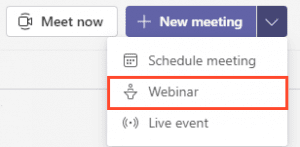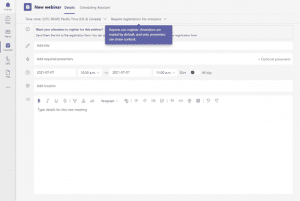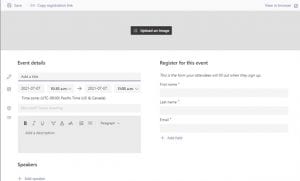Microsoft Teams was created with the Modern Workplace in mind. You’re able to chat with your team, have group meetings and video conferences, store documents to share, and call your co-workers and external contacts if needed. The one key piece that has been missing from Teams is the ability to effectively hold a webinar. Until now.
In March 2021, at the Microsoft Ignite event, the tech giant announced the official creation of webinars within the platform. You may have been using the Teams platform for webinars via the Teams Meetings or Live Events, but now you no longer need to create workarounds to the registration challenges, inability to send an email campaign, or chat limitations, among other issues.
This feature has been long awaited and companies have jumped on the platform to use the webinar features to their benefit. Let’s take a look at just how to use Microsoft Teams for your next webinar.
Microsoft Teams Webinar Licensing and attendees
To use the webinar feature within Teams, the meeting organizer will need to have a license for Office 365 or Microsoft 365 E3, E5, A3, A5, Business Standard, or Business Premium. These licenses give you the ability to create a registration page, send email confirmations to registrants, and run reports on the registration and attendance of each webinar.
The Business Standard and Business Premium licenses give you the option to have up to 300 interactive attendees in the meeting, while the E3, E5, A3 and A5 licenses let you have up to 1,000 participants. All licenses provide for 20,000 view-only attendees, until the end of 2021. This will then drop to 10,000 view-only registrants.
In addition to the license, the meeting organizer needs to have the following permissions that your IT admin can help with to be able to create a webinar:
- Permission to create live events in Microsoft Teams admin center
- Permission to create live events in Microsoft Stream
- Full team membership in the organization (you cannot be a guest or from another organization
- Private meeting scheduling, screensharing, and IP video sharing, turned on in Team meeting policy
Scheduling a meeting
If you have one of these licenses and the right permissions, you will be able to schedule a webinar by going into Microsoft Teams, selecting your calendar, and clicking on the New Meeting drop down arrow. Here you will see the webinar option for selection.

Once you click on webinar, you will see a meeting invite setup page. This page contains the Microsoft Teams meeting options you are familiar with, plus a few added elements.

Details
Time Zone and Required Registration. At the top of the page, you’ll see the drop downs for these two fields. Select the option most appropriate for your event.

Details. You’ll also notice on the details tab, the field that typically is used to invite your guests to a Teams Meeting is now being used to invite any presenter that needs to be at your event. You can add both required and optional presenters as needed.
Continue on this tab, adding your meeting title, date and time, location if necessary, and any details you want your participants and presenters to be aware of before the webinar begins.
Registration Form. This is the form your participants will fill out. You can find the link to the form directly below the Time Zone field. Click on the link to enter the form. You can customize this with a company logo or banner at the top. You can also list speakers for the event and any information that you want your attendees to provide when registering for the event.


Once you save your settings on the registration page, be sure to click on the “Copy registration link”. This will allow you to share the link by email or in other marketing communications you are using to drive attendance. When a participant clicks on the link to register, they will receive both a screen confirmation and an email confirmation with the details.
Attending the Microsoft teams meeting
Attendee experience
Once an attendee has clicked the Join Now button, from the email they were sent, they will have access to chat, raise hand, and share content. They will be able to mute and unmute their audio and use their webcam during the meeting. The attendee experience will be similar to that of a normal Teams meeting.
Presenter experience
Presenters will have the option to manage what participants are able to do during the meeting through the Meeting Options. This allows the presenter to control activities such as allowing attendees to mute/unmute, allowing them to chat, or promoting them to presenter. They can also control who can bypass the lobby at the start of the meeting and who must wait until the meeting starts. The presenter can record the webinar and has access to video, audio, and meeting controls, as well as the ability to share content.
These new features that make up the Microsoft Teams webinars have quickly been put to use by avid Teams users, even in their infancy. The fact that meetings now support up to 1,000 active attendees and have finally implemented registration forms and confirmations emails has been a nice addition to the Teams platform. Microsoft will continue to mature the webinar platform, adding additional features as their audience grows.
If you would like to learn more on how to showcase modern meetings experiences, request a Teams Meetings and Meetings Rooms workshop here.



